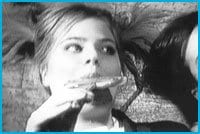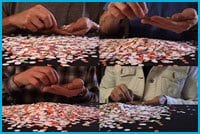GB Jones is not only a local legend but an internationally recognized pioneer of the queer punk scene. Though perhaps better known for cofounding the band Fifth Column, for her Tom Girl drawings and for her collaboration with Bruce LaBruce on the seminal queercore zine JDs, she is also a thrillingly talented Super-8 filmmaker.
Jones’s mischievous shorts, The Troublemakers (1990) and The Yo-Yo Gang (1992), follow groups of young queer misfits as they stir up shit. Her characters channel all the best clichés of juvenile delinquent movies, but with a decidedly queer twist. As much as they are comically irreverent narratives of innocence lost and of life on the rough streets for hustlers, pimps, runaways and petty criminals, they are also documents of Jones’s radical social scene of underground queer artists and “fantastics” (as Warhol would say). Riotous and exuberant, revelling in a sense of radical marginality while never taking themselves too seriously, they are glamorous fantasies of a city teeming with sexy, dangerous queer kids, created in response to a stultifying and bland Toronto.
That brings us to The Lollipop Generation, her eagerly anticipated first feature that has gone unfinished for more than a decade, which opens the 2008 Images Festival. The feature follows a teenager named Georgie (played by Jena Von Brucker) who runs away from home and ends up on the street. With a lust for lollipops, Georgie encounters all sorts of pleasures and dangers on her misadventures, eventually befriending fellow strays and throwaways Rufus (Mark Ewert), Peanut (Jane Danger) and Janie (KC_Klass). They encounter characters like The Playground Pervert (Calvin Johnson) and Retardo (Joel Gibb) as Georgie and her young friends are seduced into a world of sleazy — usually public — sex, both recreational and for profit.
Shooting on Super 8 gives Jones’s movies a dynamic energy and sense of spontaneity. “When I first started filming in 1995 I was taking my camera with me everywhere because I was on tour with Fifth Column,” says Jones. “We went all across the States and Canada and I just kept filming all the different strange little places we went to.
“For example, I went to Los Angeles to film some scenes with Vaginal Davis and with Mark Ewert. We went to Dennis Cooper’s house and filmed across the street [outside] a Catholic school. That was fun and so perfect for the movie. There was a playground, but we couldn’t really go in because there were nuns in it with the children and the gate was locked. But they certainly were watching Vaginal Davis doing her thing and they found that very interesting – good or bad I can’t tell you.”
The Lollipop Generation has acquired legendary status. Jones warns that the story behind its near-disappearance is epic: “Oh my God, I don’t know if you’ll have room in your paper to tell the whole story, it’s so huge and long.”
First, a star/producer dropped out. “He decided he didn’t want anything to do with me anymore.” Then Jones had to rethink the whole film and started shooting like mad, eventually accumulating three overflowing reels of Super-8 film or about 90 minutes. “I was trying to edit it on Super 8, and it’s almost impossible to edit a feature-length film in Super 8.”
With no money she brainstormed with star Scott Treleaven and gave up on finishing the movie, instead, releasing the soundtrack with all the songs friends had written for the film and fragments of footage similar to Davis’s The Making of The Lollipop Generation.
Then just last October, Scott Berry, executive director of Images, invited her to do a residency at Charles Street Video to complete the film digitally and premiere it at the festival. “And I thought, wow, that’s so exciting,” says Jones. That meant pulling the whole shebang together in about six months. “It was intimidating but it was good because I had to really just get all the material together and look at it for the first time.
“It’s totally changed from the beginning,” Jones says. “I see myself as being very akin to exploitation filmmakers like Ed Wood or Doris Wishman. I shoot the scenes with a vague idea of what the story could be, and then I assemble the story and the script after the footage is finished, which is not the way most people make movies.
“We did all the voices in voice-over in January, so other people were reading for almost all the roles.” This disconnect between sound and image contributes a lot to the films’ loose and scruffy appeal.
As Images approaches, Jones still has some work left. “I haven’t actually finished filming. I’m doing a little bit more in about a week.” The final cut will combine the Super-8 footage with more recent scenes shot on video.
Has the process renewed her lust for movie making? “I definitely would like to make another film, for sure. I have lots of ideas. It’s just a matter of finding the stars to be in them.”


 Why you can trust Xtra
Why you can trust Xtra


